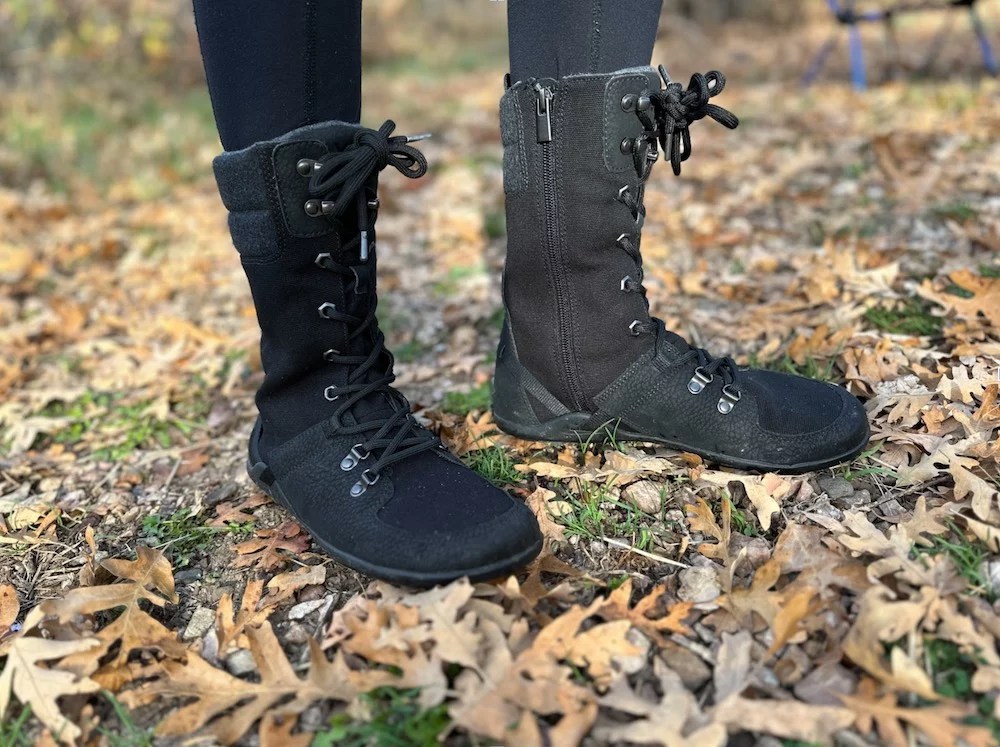When you think of barefoot shoes, boots aren’t likely what pops into your mind’s eye. Sandals? Maybe. Those shoes that look like durable gloves for your feet? Possibly. But boots? Unlikely. However, barefoot-style footwear for cooler weather can and does exist. Even better, these boots can be supremely comfy and cozy while still maintaining the delightful flexibility, balance, foot- and spine-health benefits, and connection to the earth that barefoot shoes are known for.
One of my new favorite styles for this fall and winter is the Xero Shoes Mika Boot (originally $150, now $135). After walking in these boots for miles on multiple terrains, I can confidently say they don’t disappoint!
Xero Shoes, Mika — $135.00
Originally $150, now $135
Available sizes: 5-8.5, in half sizes
Colors: 2
Materials: water-repellant canvas, heat-reflecting warming insole
- Allows feet to move naturally
- Warm
- Heat-reflective insole
- Durable and water-resistant
- Comfortable
- Limited sizing available—select colors/sizes sold out
- Not insulated—rated for mid-range temperatures
- Not waterproof
What are barefoot boots?
If you’re new to the concept of barefoot-style boots and shoes, the concept is fairly straightforward. They’re designed to have thinner, flexible soles that offer a full range of motion, no arch support, a wide toe box for the best anatomical fit, and no drop from the heel to the forefoot. The idea is to offer the most natural feel that allows for the most natural movement.
Just note, if you’re not yet used to wearing barefoot-style shoes, it might take a few weeks to get used to walking in them and you should break your feet in slowly, only wearing them for short periods of time until you do.
My review of the Xero Shoes Mika boots
First impressions
Right out of the box, the Xero Shoes Mika looks good. The soles are flexible and have a pleasantly aggressive tread pattern that makes them suitable for walking in light snow or on trails, the material feels durable, the interior is lined with a cozy felt, and the mid-calf height seems perfect for pairing them with thick leggings, hiking pants, jeans, you name it.
I especially like the addition of the heat-reflective insole, which is nice and thin to keep the soles flexible, but also contains a sort of foil material to keep heat in and cold out, a necessity when you’re wearing shoes with thinner soles. A zipper on the inside ankle makes them easy to get on and off, while stylish laces allow you to tighten or loosen the boots based on the thickness of your socks or calves.

When I first put them on to walk around the house, I found them to be immediately comfortable. It felt like wearing slippers. My feet could move, my toes had room to splay, they were soft and warm, and didn’t feel at all like walking in boots (more like high-rise slippers!)
How they feel
To find out how much I really liked them, I put them to the test outside, starting with evening walks in cool fall temperatures. I find if my feet are cold on longer walks, my whole body will get cold, too, so I was eager to see how these held up warmth-wise.
Fortunately, the Mika kept my feet warm for longer than I imagined they would in 55-degree temps, warding off the cold for several miles. Plus, they were comfy and let me run, walk, or skip without clunky or stiff soles inhibiting movement. Still, their warmth is one of the impressive things about these boots. Shortly after testing them for the first time, I packed them on a camping trip where I wore them during cool mornings and evenings with socks of average thickness. Even when not directly next to the campfire, my feet stayed mostly comfortable for a couple of hours, at least longer than they do in other barefoot shoes. That said, know the low 40s is about as cold as you can wear these boots without the chill getting in. And if you’re going to wear thick socks, I would size up, because these run a smidge small to begin with.
Durability
While the Mika isn’t specifically designed for hiking, I had no problem trekking uphill in loose rock and soil, bouncing over rocks, and hopping across creeks when I hit easy trails near my house on chilly days. All the while they offered plenty of protection from sharp rocks despite being “barefoot.”
The Mika boots aren’t designed to be waterproof, just water resistant. But they perform pretty admirably when it comes to keeping your feet dry, at least in a light shower. I could run to and from my car in a light rain—my feet stayed dry during brief activities—but I wouldn’t wear them for standing around outside in a downpour. When splashing through deep puddles or walking in consistent, prolonged, heavy wet weather, they’re not going to keep your feet completely dry for more than a minute or two, but they’re not meant to. Same goes for snow; if you’re looking for boots that will keep your feet dry while sledding or building snowmen, Xero does make waterproof boots, but these aren’t them.
Final thoughts
Honestly, this boot is perfect for all manner of fall, spring, or cool-weather activities. It would even make for a stellar winter boot if you live in a place that doesn’t regularly see lots of snow or frequent below-freezing temps. Not everyone will find them stylish—beauty is in the eye of the beholder, of course—but they do pair well with plenty of fall styles, from your favorite wide-leg jeans to leggings to a warm wool skirt.
But maybe the number one selling point is that the Mika offers complete freedom of motion and serious ground-feel while still keeping feet toasty on cool days, which makes them worth their weight in gold.
Our editors independently select these products. Making a purchase through our links may earn Well+Good a commission.









